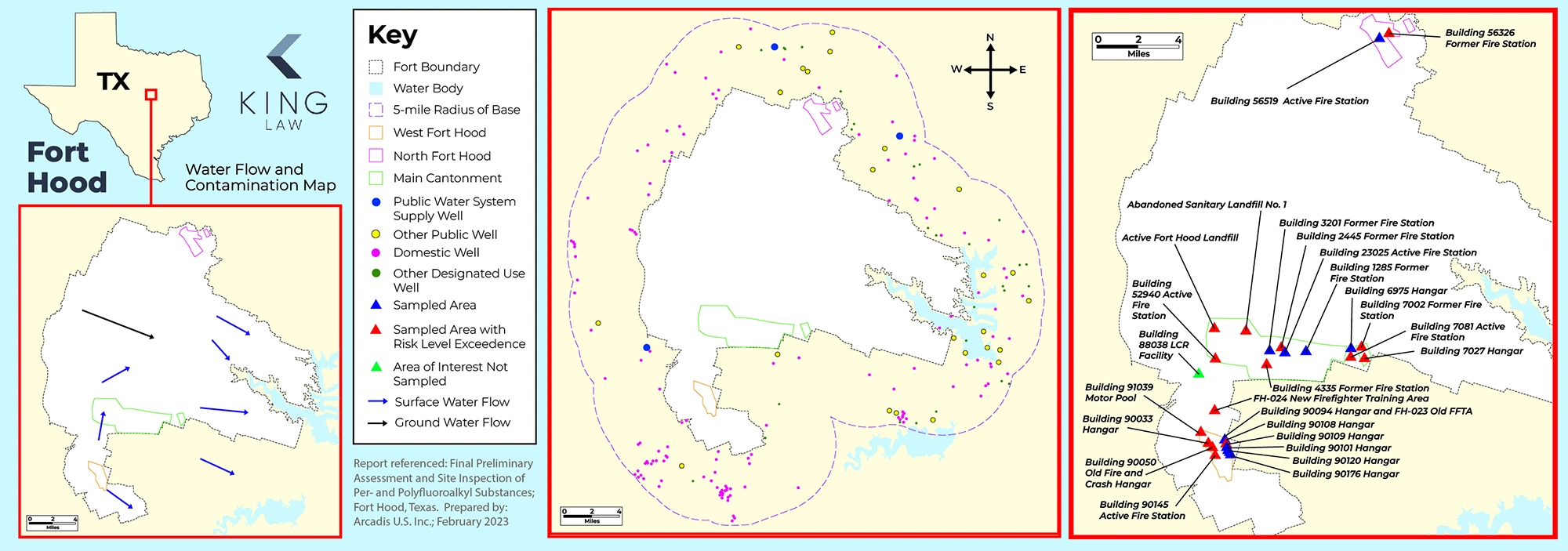
Fort Hood Water Contamination Lawsuit Overview
Fort Hood, now called Fort Cavazos, was established in 1942 and is located in Bell County and Coryell County. It was a training location for World War II tank destroyers which were then replaced with the Infantry Replacement Training Center and Field Artillery battalions. Fort Hood became a two-division post in 1967 to house the 1st and 2nd Armored Divisions. It has played a large role in training, equipment testing, tactic testing, and supporting war efforts. The Texas base underwent modernizations in the 1990s and is now considered one of the “largest active duty posts in the US Armed Services.”
Like many other American military bases, Fort Hood has dealt with PFAS water contamination. PFAS, a carcinogen found in Aqueous Film Forming Foam (AFFF) , entered soil, groundwater, and drinking water when the military used firefighting foam at training facilities. Exposure to PFAS is extremely dangerous and can cause thyroid disease, thyroid cancer, testicular cancer, and kidney cancer. Those who were exposed at Fort Hood and diagnosed with a related illness may be able to file an AFFF lawsuit.
Fort Hood Water Contamination Lawsuit Updates
King Law is reviewing cases of Fort Hood water contamination. If you’ve been exposed to PFAS from Fort Hood and developed a related illness, you may be eligible for compensation.
March 2024 – Plaintiffs Sue Chemical Manufacturers for PFAS Water Contamination
Thousands of veterans and their family members are filing claims after developing illnesses related to drinking PFAS-contaminated water. Military bases like Fort Hood utilized firefighting foam containing PFAS, which polluted drinking water supplies that military members, their families, and civilians used. Victims are now seeking action through PFAS lawsuits to recover compensation.
February 2024 – Texas Farmers Sue Because of PFAS Contamination
A journal from the Environmental Working Group (EWG) shared how Texas families are suing a manufacturer of PFAS-containing products. They claim their pets and animals faced sickness and death because of PFAS. The article also noted how other farms across the United States have dealt with PFAS contamination in their livestock, lands, and water, some of which were located near military bases.
On this page:
Background of Toxic Exposure at Fort Hood
Fort Hood Water Contamination Map
Contaminants Found in Fort Hood Drinking Water
Current Water Quality at Fort Hood
Health Risks Linked to Drinking Water at Fort Hood
Eligibility Criteria for Fort Hood Water Contamination Lawsuit
Fort Hood Water Contamination Settlement Amounts
How to File a Fort Hood Water Contamination Lawsuit
Background of Toxic Exposure at Fort Hood
August 2023 – PFHxS Tests 50 Times the Health Advisory
PFHxS belongs to the PFAS chemical group and is considered a GenX chemical. In 2022, the Environmental Protection Agency (EPA) issued a health advisory of 10 ppt for GenX chemicals. According to the EWG, Fort Hood’s highest contaminant was PFHxS at 500 ppt, which is 50 times the health advisory.
December 2022 – DoD Identifies PFAS Contamination At Fort Hood
The Department of Defense (DoD) conducted a study in April 2022 to determine how many military installations were affected by PFAS, also known as “forever chemicals.” Fort Hood was on this list with PFAS levels of 2.4 ppt listed.
EWG’s 2021 Tap Water Update Detects 15 Contaminants Exceeding Health Guidelines
According to the EWG’s Tap Water Database – 2021 Update, South Fort Hood had a total of 32 contaminants, 15 of which exceeded EWG Health Guidelines. Toxins with the highest levels included:
- Arsenic: 97x EWG Health Guideline
- Bromochloroacetic acid: 245x EWG Health Guideline
- Bromodichloromethane: 197x EWG Health Guideline
- Haloacetic acids (HAA5): 123x EWG Health Guideline
- Haloacetic acids (HAA9): 645x EWG Health Guideline
- Trihalomethanes: 214x EWG Health Guideline
March 2016 – DoD Announces Plans to Look for PFAS Contamination at Fort Hood
The DoD released a list of 664 military sites it planned to examine for PFAS contamination. All of these sites were areas where the military did fire and crash training, relying on firefighting foams to put out and contain fires.

Fort Hood Water Contamination Map

The above map shows the layout of Fort Hood, potential sources of PFAS contamination, and the nature of its spread. Utilize the key to identify key areas of interest and to understand how military activity and use of AFFF contributed to environmental contamination on base.
Contaminants Found in Fort Hood Drinking Water
PFAS is one of the biggest contaminants of concern at Fort Hood. The manufactured chemicals have been in use since the 1940s and are still present in drinking water across the United States. Water at Fort Hood and surrounding communities undergoes frequent testing for other toxins, such as arsenic and high levels of disinfectants that can also increase cancer risk.
Per- and Poly-Fluorinated Substances (PFAS)
PFAS chemicals are particularly dangerous because they build up in the body and can lead to life-threatening illnesses, including thyroid cancer, thyroid disease, kidney cancer, testicular cancer, and bladder cancer.
PFAS at Fort Hood stems from the use of firefighting foam that contained the toxin. It was used by the military for decades and seeped into the ground where it contaminated soil and groundwater. Many veterans and their families consumed water contaminated with PFAS after it migrated into drinking water supplies at military bases.
Other Contaminants
PFAS has been the biggest concern for Fort Hood water. However, it has tested positive for other toxins, including:
- Arsenic: Chronic exposure can lead to skin cancer, renal cancer, bladder cancer, lung cancer, and hypertension.
- Disinfectants and byproducts: Fort Hood tap water has tested positive for a variety of disinfectants and their byproducts that are used to treat water. They may increase the risk of bladder cancer, colorectal cancer, mesothelioma, and more.
Current Water Quality at Fort Hood
The most recent water quality reports for Fort Hood and for Bell County indicate that all toxins tested fell below regulatory limits. However, the U.S. Army website states the most recent test results for PFOA+PFOS (part of the PFAS chemical group) tested at 2.3 ppt. While this is below the EPA’s 2016 Lifetime Health Advisory (LHA) level of 70 ppt, the EPA released an interim updated health advisory of 0.004 ppt for PFOA and 0.02 for PFOS, which is much lower than this test result.
Water Treatment Efforts at Fort Hood
Fort Hood’s current CERCLA phase is listed as “Remedial Investigation underway.” CERCLA (the Comprehensive Environmental Response, Compensation, and Liability Act) is a years-long, multi-phase process designed to clean up environmental contaminants. Remedial investigation is when officials seek to understand the extent and risk of contamination, but no clean-up efforts have begun.
Fort Hood’s drinking water is largely obtained from Belton Lake, a source of surface water. The base purchases treated drinking water for South and West Fort Hood from Bell County Water Control and Improvement. The water is treated with a variety of techniques, including chemical coagulation, filtration, and disinfection.
Health Risks Linked to Drinking Water at Fort Hood
There are numerous health risks associated with contaminated drinking water at Fort Hood, including:
- Testicular cancer
- Pancreatic cancer
- Kidney cancer
- Thyroid Cancer
- Other thyroid issues
- Birth defects
- Changes in liver enzymes
- Neurological disorders
- Respiratory illnesses
- Lower vaccine effectiveness
Our firm is currently evaluating cases where individuals have been diagnosed with the following illnesses:
If you have any symptoms related to water contamination, seek care immediately. Tell a health professional about your exposure so they can monitor for illnesses proactively.
Eligibility Criteria for Fort Hood Water Contamination Lawsuit
You may be able to file a Fort Hood water contamination lawsuit if you have:
- At least 6 months of exposure: We typically look for claimants to have at least 6 months of proven exposure to water contaminants like PFAS to build a substantial case.
- A related diagnosis: We are reviewing cases of thyroid disease, thyroid cancer, kidney cancer, and testicular cancer associated with exposure to Fort Hood water contaminants.
Our firm is currently evaluating cases where individuals have been diagnosed with the following illnesses:
- Kidney Cancer
- Liver Cancer
- Non-Hodgkin’s Lymphoma
- Testicular Cancer
- Thyroid Cancer
- Thyroid Disease
- Ulcerative Colitis
There are deadlines by which you must file water contamination claims, so ensure you contact a legal professional as soon as possible to ensure your best chances at compensation. We have a team of experienced attorneys who can help you get started.
Fort Hood Water Contamination Settlement Amounts
King Law anticipates settlement amounts of around $100,000-$300,000 with an average payout of $250,000. The actual amount you can get from a PFAS lawsuit will depend on factors like how old you were when you were exposed, the severity of your diagnosis, and the duration of your exposure.
Cases that lack evidence may payout at around $30,000-$75,000. But if you have a strong case with details like long-term exposure and diagnosis of a very severe illness, you could face a payout closer to $1,000,000. Our attorneys have experience with toxic exposure cases and can help you understand the strength and potential of your claim.
How to File a Fort Hood Water Contamination Lawsuit
Here’s the typical process to file a Fort Hood water contamination lawsuit:
- Reach out to an attorney who has a background in environmental law and toxic torts, like we do at King Law, to ensure your case is handled with confidence and expertise.
- Gather evidence like medical records, military directives, discharge paperwork, and medical bills that prove you were stationed at Fort Hood, exposed to a toxin like PFAS for at least 6 months, and developed a related illness.
- We will draft and file your claim with the appropriate court, listing the responsible party, who is often the PFAS-containing product manufacturer.
- We will work toward a settlement or verdict and can negotiate on your behalf if a settlement is the best option for you.
- In successful cases, you will receive your payout and can use the compensation to recover lost wages and medical bills.
Toxic exposure claims can take several months or longer to resolve. Contact us as soon as possible so we can begin building your case and using our unparalleled quality representation to get you the compensation you deserve.
Evidence to Support Your Fort Hood Claim
Strive to provide the following evidence to establish your Fort Hood legal claim:
- Proof that you were stationed at Fort Hood, such as military directives, deployment records, and discharge paperwork, if applicable
- Proof of an exposure-related diagnosis, such as medical records
- Any other details around the nature and duration of your toxic exposure
- Any other details about the severity of your illness, prognosis, and treatment
- Studies, reports, and other authoritative records proving the risks associated with exposure to the toxin
- Support testimonies from doctors, scientists, coworkers, and others to substantiate your claim
Ensure you’re available to your attorney in the event that they have additional questions or requests that will propel your case.
Fort Hood Water Contamination Lawyers
Our attorneys have experience handling military cases that involve toxic exposure. We understand what it takes to build a successful case and have both the background and resources necessary to provide unmatched representation. Know that you are in good hands as we guide you through the entire legal process with confidence and precision, available to answer any questions you have along the way. Reach out today to get the help you deserve.
Frequently Asked Questions (FAQs)
Get answers to these frequently asked questions about Fort Hood water contamination and toxic exposure lawsuits.

